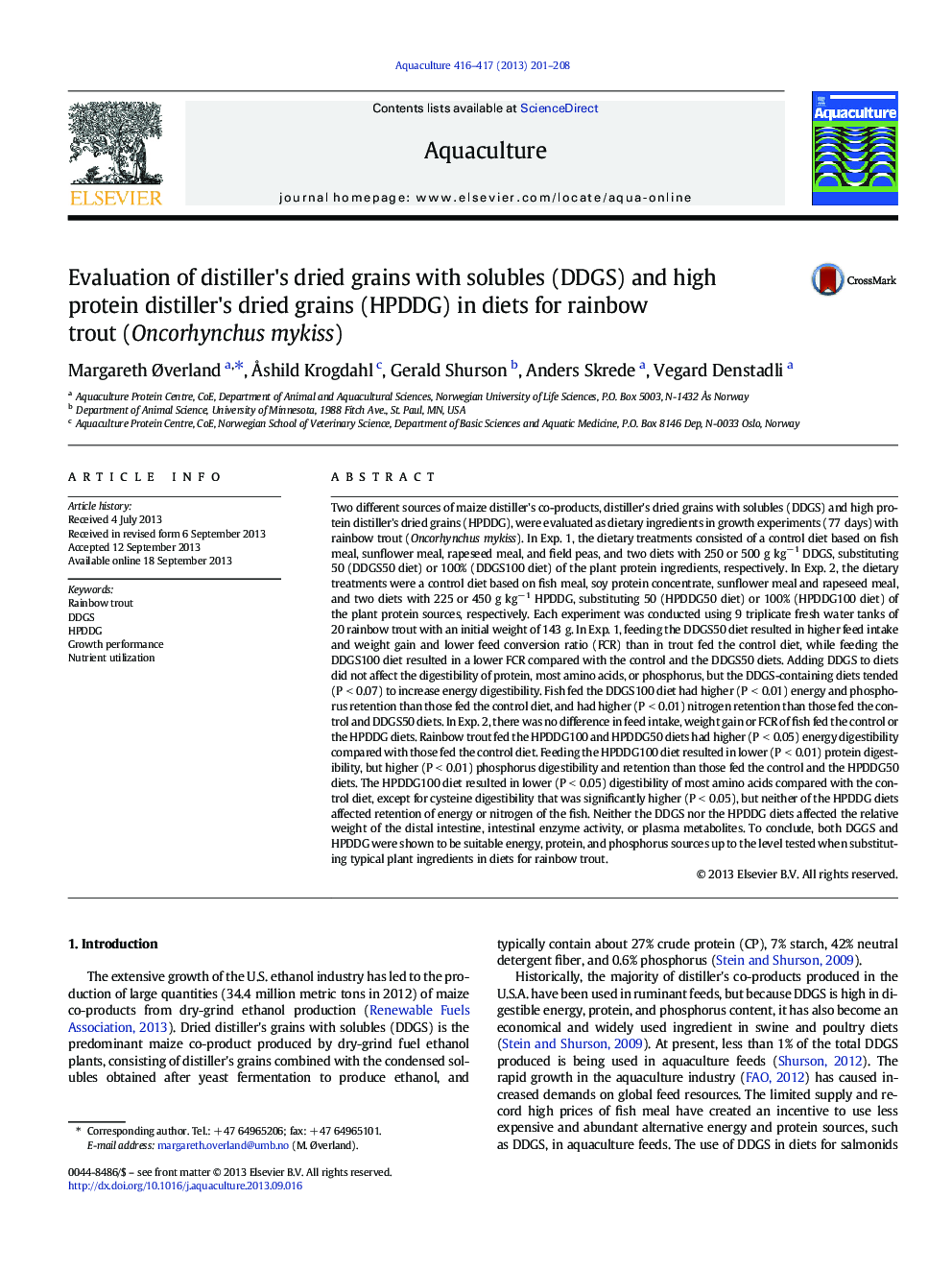| کد مقاله | کد نشریه | سال انتشار | مقاله انگلیسی | نسخه تمام متن |
|---|---|---|---|---|
| 2422040 | 1552865 | 2013 | 8 صفحه PDF | دانلود رایگان |

• We evaluated DDGS and HPDDG in diets for rainbow trout.
• Both DDGS and HPDDG were suitable protein, energy and phosphorus sources.
• The results demonstrate the potential of maize distiller's co-products in aquafeeds.
Two different sources of maize distiller's co-products, distiller's dried grains with solubles (DDGS) and high protein distiller's dried grains (HPDDG), were evaluated as dietary ingredients in growth experiments (77 days) with rainbow trout (Oncorhynchus mykiss). In Exp. 1, the dietary treatments consisted of a control diet based on fish meal, sunflower meal, rapeseed meal, and field peas, and two diets with 250 or 500 g kg− 1 DDGS, substituting 50 (DDGS50 diet) or 100% (DDGS100 diet) of the plant protein ingredients, respectively. In Exp. 2, the dietary treatments were a control diet based on fish meal, soy protein concentrate, sunflower meal and rapeseed meal, and two diets with 225 or 450 g kg− 1 HPDDG, substituting 50 (HPDDG50 diet) or 100% (HPDDG100 diet) of the plant protein sources, respectively. Each experiment was conducted using 9 triplicate fresh water tanks of 20 rainbow trout with an initial weight of 143 g. In Exp. 1, feeding the DDGS50 diet resulted in higher feed intake and weight gain and lower feed conversion ratio (FCR) than in trout fed the control diet, while feeding the DDGS100 diet resulted in a lower FCR compared with the control and the DDGS50 diets. Adding DDGS to diets did not affect the digestibility of protein, most amino acids, or phosphorus, but the DDGS-containing diets tended (P < 0.07) to increase energy digestibility. Fish fed the DDGS100 diet had higher (P < 0.01) energy and phosphorus retention than those fed the control diet, and had higher (P < 0.01) nitrogen retention than those fed the control and DDGS50 diets. In Exp. 2, there was no difference in feed intake, weight gain or FCR of fish fed the control or the HPDDG diets. Rainbow trout fed the HPDDG100 and HPDDG50 diets had higher (P < 0.05) energy digestibility compared with those fed the control diet. Feeding the HPDDG100 diet resulted in lower (P < 0.01) protein digestibility, but higher (P < 0.01) phosphorus digestibility and retention than those fed the control and the HPDDG50 diets. The HPDDG100 diet resulted in lower (P < 0.05) digestibility of most amino acids compared with the control diet, except for cysteine digestibility that was significantly higher (P < 0.05), but neither of the HPDDG diets affected retention of energy or nitrogen of the fish. Neither the DDGS nor the HPDDG diets affected the relative weight of the distal intestine, intestinal enzyme activity, or plasma metabolites. To conclude, both DGGS and HPDDG were shown to be suitable energy, protein, and phosphorus sources up to the level tested when substituting typical plant ingredients in diets for rainbow trout.
Journal: Aquaculture - Volumes 416–417, 5 December 2013, Pages 201–208